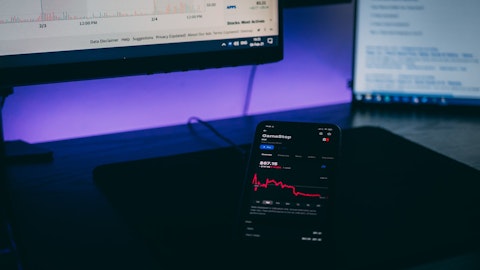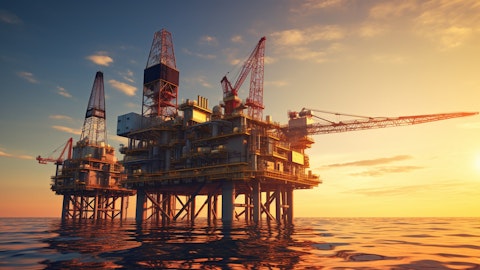One, large capital program, Q1, would have impacted that. Secondly, maybe not as obvious, we talked about our notes. Those are all U.S. dollar-denominated notes. So at year-end, FX rates would have been about 1.32. They’ve moved to 1.35. So that $0.03 move increased our debt at quarter-end by approximately $50 million.
Eric Greager: And you express it in Canadian dollars, correct?
Chad Kalmakoff: As a Canadian reporting issuer. Now, that being said, obviously that impacts our debt levels. A weaker Canadian dollar is actually net beneficial to our business. Obviously the value of our U.S. business in total would have a large increase with the relative weakening of the Canadian dollar. Lastly, as Eric just mentioned, we did have a $35 million land purchase in the New Bernet High prospect is something we’re pretty excited about. So those would be the large contributing factors to the non-debt reduction. I’ll just conclude by saying we realize investors are looking for some debt reduction, as are we. We are committed to debt reduction and we are confident we’ll reach our debt targets.
Brian Ector: Thank you. Thank you, Chad. And keeping on the line, I’ll repeat this question that came in as well. We touched on the debt repayment plan. And I’ll turn this over to Eric for a bit broader conversation on capital allocation. What are our priorities? Debt repayment, shareholder returns, the buyback program versus the dividend?
Eric Greager: Yes. So let me unpack that. Our priorities remain 50% of our free cash flow allocated to debt repayment, as Chad Kalmakoff just took us through, and the other 50% to direct shareholder returns. And the direct shareholder returns are biased in terms of the size of that 50% allocated to our normal course issuer bid. In the last three quarters, we’ve taken out 5.5% of our total shares outstanding, and that will continue. And of course, the other part of that direct shareholder return portion of the allocation is our fixed base dividend. And that fixed base dividend, of course, is currently set at $0.09 per share per year or $0.0225 per quarter per share. And that remains part of the 50%. So I guess what I would say simply is it’s 50-50, and you could ask 100 shareholders their priorities, and you could get something like 50 different answers.
Some people like more dividends, some people like more share repurchases, and others like 100% to debt. And because we look at it over time and on a balanced and reinforced framework that doesn’t kind of whipsaw quarter-to-quarter, we like this 50-50 allocation. We think this threads the needle between pleasing the broadest possible cross-section of shareholders. So let me just stop there, Brian.
Brian Ector: And then continuing on the question around the dividends, Eric, are there any conditions where shareholders could expect to see a dividend increase, and would we ever consider a special dividend at some other companies have put in place?
Eric Greager: Yes, so special dividends are real challenging for issuers, particularly if they’re kind of special one-time dividends, surprises essentially. They’re great for shareholders, but it’s very difficult for the issuer to get value embedded in the stock, because nobody knows how to discount the probability when that will happen and how big it will happen. Now, variable dividends are a different construct around special variable dividends. And if you have a very rigorous formulaic approach, to how you go about quantifying the forward variable dividends, that’s something I’ve seen done, and I think that can get priced into the stock. I would say the third thing is on raising the dividends, one of the reasons we started with a modest fixed-base dividend currently yielding, let’s call it 1.8%, was to give us the opportunity over time to increase the dividend on a per-share basis and hopefully on a yield basis consistently over time.
Now, we haven’t so far because we’ve only been at this now for three quarters, but it is certainly our desire to, over the long arc of time, create a track record of raising our fixed-base dividend and our dividend yield over time as part of our total shareholder returns framework. Now, the last part I’ll say on this, it’s not specifically around dividends or the dividend question, but when we take 50% of our free cash flow and we allocate it to reducing our debt, even though that’s not part of our direct shareholder return framework, it’s still meaningfully impactful to share price appreciation because if you assume for the moment that all things equal, the enterprise is going to be able to pay back the share price, the share price is going to be able to pay back the dividend, and that’s not going to be a direct shareholder return.
If the enterprise value of the business stays the same over time, then every dollar of debt you reduce becomes a dollar of equity increased in the business. This is something we recognize. So, essentially, the full $700 million of free cash flow generated this year goes to direct shareholder returns to the 50% NCIB and dividends, but indirectly, as we pay down debt, goes to share price appreciation because it moves from the debt side of your EV to the equity side of your EV. This is where we really think there’s some substantial acceleration or compounding of the benefits. If we buy back 7% or 8% of our total shares outstanding each year and we add to that 7% or 8% a 2% fixed base dividend and then we add to that 2% top line production growth, that’s a 12% total shareholder return on the sum of those three parts.
And then when you add to it the additional 50% allocation to debt that kind of puts goose and acceleration in that, it’s meaningfully north of the 12% TSR. So, that’s a fairly fulsome discussion, I think, around shareholder return framework.
Brian Ector: Thanks, Eric. Back to Chad Kalmakoff. Just really quickly, Chad, can you — during the quarter, we had a press release around seeking exemptive relief for our normal course issuer bid. Can you just explain the plan? What does that relate to?
Chad Kalmakoff: Sure. Thanks, Brian. That exemptive relief is really to allow us to buy additional shares directly through the NYSE versus the TSX. So, really just kind of directing some of our NTIB to U.S. shareholders versus the Canadian shareholders. We need a relief to do that. Generally speaking, we buy off both exchanges, but we have been a little bit more directed to the U.S. exchange, partly to ensure that we maintain our foreign private issuer status.
Brian Ector: Okay. Thanks, Chad. So, we touched on the debt repayment plan, normal course issuer bid, the dividends. Eric, one more question, and this relates to another use of the free cash flow and capital, and that relates to production growth. So, how do you think about balancing current production and cash flow goals versus incremental spending to generate production growth? And what are the tradeoffs as you think about the company’s future?
Eric Greager: Yes. Thanks, Brian. It’s a great question. Those of you who have indulged in our IR deck online know that we’ve got a 1% to 4% range over the five-year plan, our LRP, and we talk often about 2% per year. It’s just handy shorthand for the midpoint of that growth range in terms of top-line production growth per year. The 2% essentially is meant to be just north of flat such that you can, with some certainty, ensure that you don’t create back-to-back sequential quarters of negative growth, right? So, because that has negative optics around sequential negative production growth, what you’d like to do is, if you have a quarter that goes down relative to the subsequent quarter, you’d like it to be only one quarter and not a pair of quarters.
2% generally does that if you use a shorthand math and given the seasonality of our business and where we operate. And so, we think that’s just right. Otherwise, you could just say just barely north of flat. And what does just barely north of flat production mean in terms of maintenance capital? It means you’re maximizing your free cash flow generation. And that is our commitment. Our commitment is to allocate our capital to the highest returning projects and maintain the maximum operational efficiency in each part of our portfolio while not growing any faster than necessary so that we can maximize free cash flow generation and allocate that free cash flow to debt reduction, share repurchases, and our dividend.





